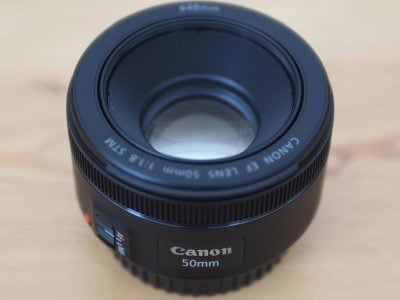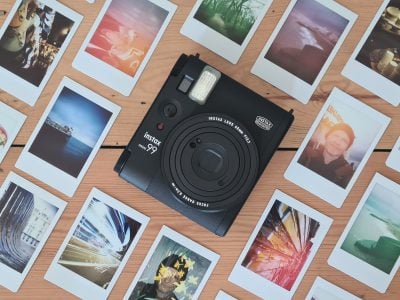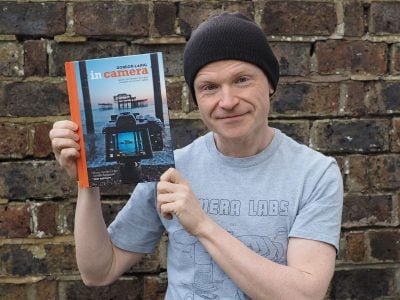Fujifilm FinePix S8000fd
-
-
Written by Gordon Laing
Fujifilm FinePix S8000fd lens and stabilisation
The Fujifilm FinePix S8000fd is equipped with an 18x optical zoom delivering an equivalent range of 27-486mm with a focal ratio of f2.8-4.5; the actual focal length is 4.7-84.2mm and the closest focusing distance is 1cm in Super-Macro mode with the lens zoomed all the way out. In Super-macro we captured an area measuring just 28x21mm with surprisingly little distortion.
The 18x lens is of course the big selling point for the S8000fd, covering everything from decent wide angle to more than decent telephoto capabilities. Upon power-up the lens barrel extends by 24mm with the camera ready for action in about 2.5 seconds; fully zoom the lens in and it extends by 61mm as seen in the photos below. There’s only one zoom speed and it takes about 2.5 seconds to extend from wide angle to the longest telephoto. The actual zoom increments are quite smooth with about 37 discrete steps.
The lens range is a highlight on the S8000fd, but as mentioned on the previous page, there’s a sense of déjà-vu, as it appears to have an identical specification to that of the Olympus SP-550UZ / SP-560UZ. As we’ll see later in the review, it also suffers from the same problems as that lens. Before going further it’s also worth mentioning how the lens specifications compare to its other 18x rival, the Panasonic Lumix FZ18. This offers a similar range of 28-504mm, but has two different zoom speeds and much finer increments.
You’ll notice the equivalent coverage is slightly different between the Fujifilm and Panasonic models, and to illustrate this, along with the massive scope of an 18x lens, we took photos from exactly the same spot using both cameras, first zoomed-out, then all the way in.
|
Fujifilm FinePix S8000fd coverage wide |
Panasonic Lumix DMC-FZ18 coverage wide | |
 |  | |
4.7-84.2mm at 4.7mm (27mm equivalent) |
4.6-82.8mm at 4.6mm (28mm equivalent) |
Both cameras sport 18x optical zooms, but the equivalent ranges are slightly different. Panasonic’s FZ18 offers an equivalent range of 28-504mm, while Fujifilm’s S8000fd offers 27-486mm. One millimetre difference at the wide angle end doesn’t sound like much, but judging from the samples above, the Fujifilm does indeed capture a slightly wider field of view – the mountain range extends a little further in both directions, and slightly more of the town is visible.
Fujifilm FinePix S8000fd coverage tele |
Panasonic Lumix DMC-FZ18 coverage tele | |
 |  | |
4.7-84.2mm at 84.2mm (486mm equivalent) |
4.6-82.8mm at 82.8mm (504mm equivalent) |
Zoom both cameras in fully and they appear to deliver the same result as seen above, but look very closely and the Panasonic is fractionally tighter, although not so much it makes any real difference. So technically speaking, the Fuji gets a little wider and the Panasonic fractionally closer, but there’s really not much between them in terms of coverage. Both cameras offer a fantastically versatile range which covers almost every eventuality; there are however differences in their optical quality which we’ll cover later.
The S8000fd features image stabilisation by physically shifting its sensor. The facility is activated by pressing a button on the camera’s top surface after which stabilisation takes place when you half-press the shutter release. Fujifilm actually refers to the system as Dual IS, where the second system increases the ISO to achieve faster shutter speeds. This of course will impact image quality, but luckily you can lock the ISO to a setting of your choice.
Fujifilm FinePix S8000fd Image Stabilisation off / on | ||
 |  | |
100% crop, 4.7-84.2mm at 84.2mm, 1/30, 64 ISO, IS off |
100% crop, 4.7-84.2mm at 84.2mm, 1/30, 64 ISO, IS on | |
In tests we found the S8000fd’s image stabilisation allowed us to handhold shots fully zoomed-in with shutter speeds as slow as 1/30; these required at least 1/125 to avoid camera shake without stabilisation, corresponding to over two stops of compensation. You can see a demonstration of the IS system in practice, along with the lens coverage in our S8000fd video tour.
Fujifilm FinePix S8000fd focusing and flash
 |
 |
The S8000fd offers three AF areas: Center, Multi and Area, the latter allowing you to manually adjust the position of the focusing point. The camera also offers three AF modes: Continuous (for moving subjects although with higher battery drain), Single and Manual focus.
Manual focusing on the S8000fd is slightly odd in operation. You’ll first need to press and hold the exposure compensation button while you push the zoom rocker one way or the other. There’s no scale or magnified view on-screen while you do this, just the faint sound of the lens adjusting and a guide in the centre which turns yellow when the subject is in focus. It’s good to have manual focusing on the S8000fd, but it’s not as practical an implementation as seen on its rivals from Olympus and Panasonic.
 |
The ‘fd’ in the camera’s name stands for face detection and can recognise up to ten subjects in the frame. Face detection can also be used to identify eyes and correct for red-eye if desired. In use the S8000fd’s face detection certainly locked onto subjects, but generally only when they were at least half turned to face the camera. It certainly didn’t recognise profiles as well as the FinePix F50fd.
Fujifilm’s Intelligent Flash system also attempts to record more of the background in darker situations by increasing the sensitivity in Auto ISO modes. In use this can certainly deliver nicer-looking compositions compared to the usual dark backgrounds in most flash photos, but in our tests the FS8000fd (like the F50fd) generally achieved this by using 800 ISO sensitivity. Consequently while more of the background was visible, the noise levels were much higher. You can however force the S8000fd to use a sensitivity of your choice though or limit the auto setting to a maximum of 400, 800 or 1600 ISO.
Fujifilm FinePix S8000fd sensor and processing
The Fujifilm FinePix S8000fd is equipped with an 8 Megapixel CCD sensor, measuring 1/ 2.35in. This generates 4:3 images with a maximum resolution of 3264×2448 pixels, and there’s the choice of three lower resolutions or a cropped 3:2 aspect ratio mode. The top 8M mode is available in two resolutions, Fine and Normal, with the former typically measuring 3MB each; there’s a fairly generous 58MB of built-in memory to get you started and a dual-media memory slot which can take xD or SD cards. Sadly unlike both the Panasonic FZ18 and Olympus SP-550UZ / SP-560UZ, there’s no RAW option.
 |
 |
 |
|
|
The image quality is selected from the F-Mode menu, where you’ll also find sensitivity. This is offered in a wide range from 64 to 6400 ISO, with 3200 and 6400 ISO operating at a reduced resolution of 4 Megapixels. You can see samples using the complete range of sensitivities on our S8000fd noise results page.
Also in the F-Mode menu is an option to change the colour mode from Standard to the more vibrant F-Chrome mode or to Black and White. All our test shots were taken with the default Standard mode. Finally, the S8000fd offers adjustable sharpness settings of Hard, Standard or Soft; again we used the default Standard setting for our test shots.
Fujifilm FinePix S8000fd movies
 |
Turn the mode dial to the movie camera icon and the S8000fd can record video in either 640×480 or 320×240 pixels at 30fps. Files are recorded in the Motion JPEG AVI format and you’re looking at just under 1MB per second in the best quality mode; the maximum file size is 2GB.
The quality in the 640×480 pixel movie mode was good and the stabilisation helps iron-out any wobbles. Note, like most digital cameras, you can’t adjust the optical zoom once you start filming.
Fujifilm FinePix S8000fd burst shooting
 |
The FinePix S8000fd offers five different continuous shooting options. ‘Top 3’ mode shoots up to three full resolution frames at 1.5fps. ‘Top 15 4M’ shoots up to 15 4 Megapixel images at 7fps, while ‘Top 15 2M’ shoots up to 15 2 Megapixel frames at 15fps. The Long period option allows you to shoot full resolution images until you run out of memory, although at a slow speed of 0.5fps.
We confirmed these shooting rates in tests and found the Top 15 modes could be great for capturing fast action, and were well worth considering even with their lower recording resolutions.




